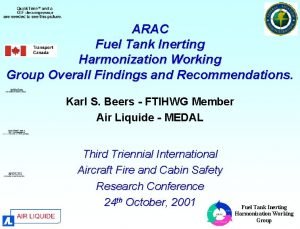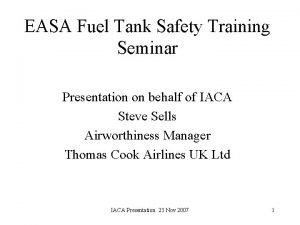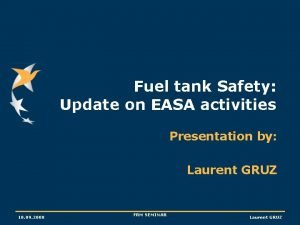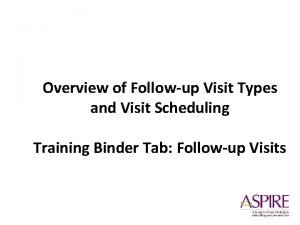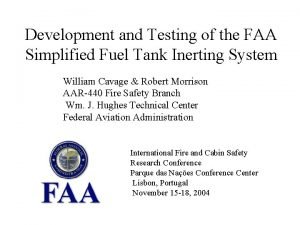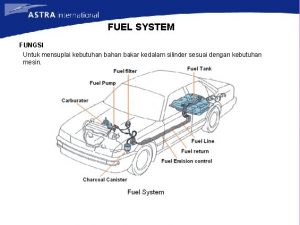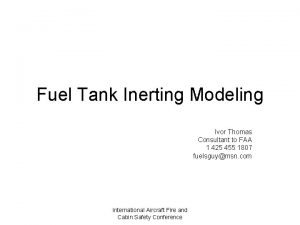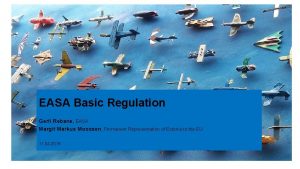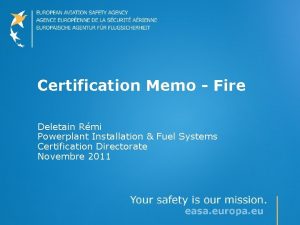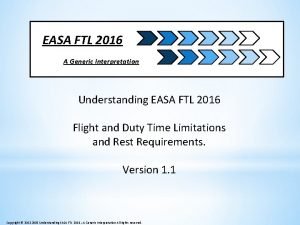Followup on Fuel Tank Safety Remi Deletain EASA










- Slides: 10

Follow-up on Fuel Tank Safety Remi Deletain EASA Certification Directorate 28 october 2010

EASA Fuel Tank Safety EASA activities on fuel tank safety Training for maintenance: AMC to Part-M and Part-145: decision to be effective on 31 st March Task 25. 056 (b) NPA for CS-25: included in amendment 6 to CS-25 Production cut-in: Agreed with FAA that we would do it FAR 26 assessment Assistance to FAA Task 25. 056 (a) Review of 2004 Regulatory Impact Assessment (Retrofit issue) 28 october 2010 Fuel Tank Safety 2

EASA Fuel Tank Safety The revised RIA submitted by the group concluded: The group does not recommend additional EASA action beyond CS-25 and production cut-in Statistical risk: 1 accident between now and 2030 Cost: 2. 8 Billion EUROS 28 october 2010 Fuel Tank Safety 3

EASA Fuel Tank Safety Review by the Agency: The Agency regards the risk of accident that implies a very high probability of loss of all lives on board as critical to its decision making process As a result the Agency has determined that it will mandate as a preferred option: a production cut-in and the retrofit to the existing fleet 28 october 2010 Fuel Tank Safety 4

EASA Fuel Tank Safety Production cut-in: The Agency will amend the TCDS of Airbus and Boeing aircraft still under production at the end of 2011: More information may be found in SIB 2010 -10 available at: http: //ad. easa. europa. eu/ad/2010 -10 28 october 2010 Fuel Tank Safety 5

EASA Fuel Tank Safety Retrofit (I) The affected large aeroplanes are those with a type certificate issued after January 1, 1958, that, as a result of original type certification or later increase in capacity have: 1) A maximum type-certificated passenger capacity of 30 or more, or (2) A maximum payload capacity of 7, 500 pounds or more. However, Cargo aircraft will be excluded from retrofit as well as aircraft that have received a first certificate of airworthiness before 1997 (25 years or more at the effective date of the rule). 28 october 2010 Fuel Tank Safety 6

EASA Fuel Tank Safety Retrofit (II): Task 26. 008. NPA to be issued before the end of 2010 NPA has been delayed compared to the original intent (End 2009) The NPA will anticipate on the regulatory framework to be put in place in application of regulation 216/ 2008 article 5 paragraph 4 (e) (vi) The rulemaking task will follow the principles proposed by NETS (Navigating towards an Enhanced Transparency System) 28 october 2010 Fuel Tank Safety 7

EASA Fuel Tank Safety Retrofit (III): The intended dates for retrofit would be as follows: 50% of the fleet of each affected operator by September 19, 2019 100% of the fleet by September 19, 2022 Options: Do nothing: will provide the baseline Implement production cut-in only Implement production cut-in and further mitigation measures Implement production cut in and retrofit 28 october 2010 Fuel Tank Safety 8

EASA Fuel Tank Safety Retrofit (IV): The preferred option proposed by the NPA will be the fourth one based on the following arguments: A statistical risk of 1 accident between now and 2030 exists. Nature of the potential accident. The incorporation of a FRM may protect from other threats The decision of the FAA to mandate the retrofit on a major part of their type certificated aeroplanes will likely be followed by other countries Foreign operators may use as a commercial argument the fact that they are equipped with FRM. Leasing companies are pushing for harmonised regulation on this issue. 28 october 2010 Fuel Tank Safety 9

Thank you for your attention Your questions are welcome 28 october 2010 Fuel Tank Safety 10
